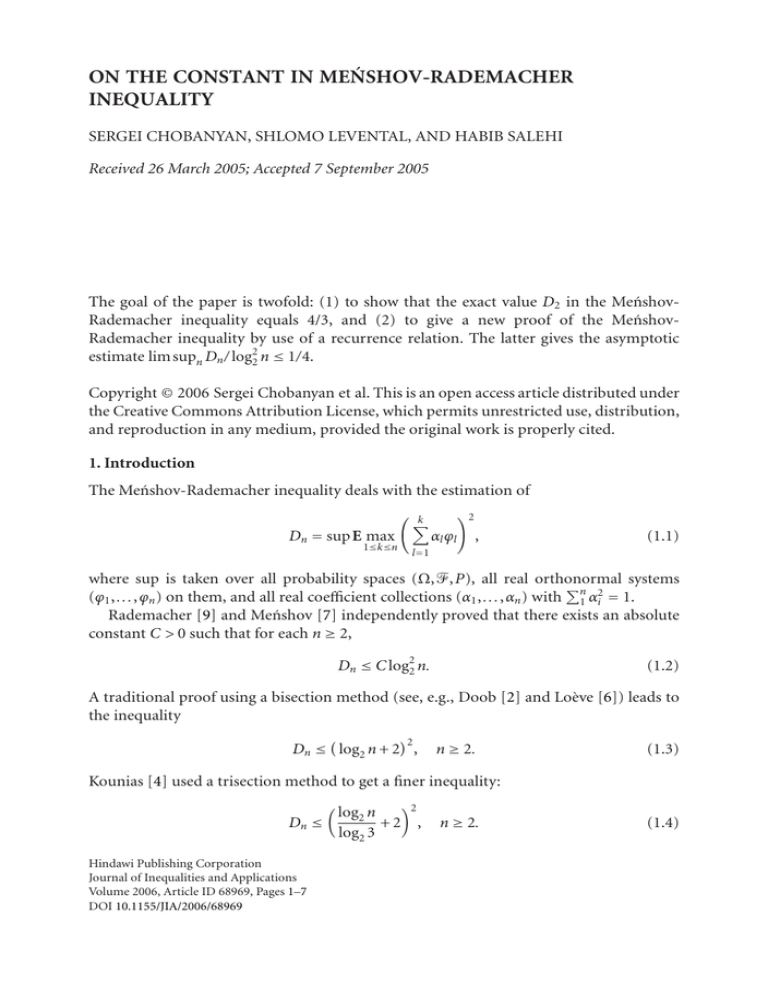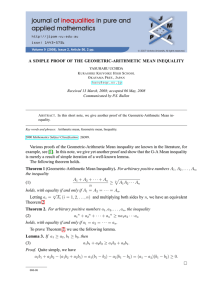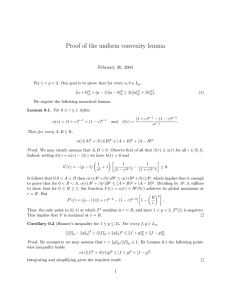ON THE CONSTANT IN ME ´ NSHOV-RADEMACHER INEQUALITY
advertisement

ON THE CONSTANT IN MEŃSHOV-RADEMACHER
INEQUALITY
SERGEI CHOBANYAN, SHLOMO LEVENTAL, AND HABIB SALEHI
Received 26 March 2005; Accepted 7 September 2005
The goal of the paper is twofold: (1) to show that the exact value D2 in the MeńshovRademacher inequality equals 4/3, and (2) to give a new proof of the MeńshovRademacher inequality by use of a recurrence relation. The latter gives the asymptotic
estimate limsupn Dn / log22 n ≤ 1/4.
Copyright © 2006 Sergei Chobanyan et al. This is an open access article distributed under
the Creative Commons Attribution License, which permits unrestricted use, distribution,
and reproduction in any medium, provided the original work is properly cited.
1. Introduction
The Meńshov-Rademacher inequality deals with the estimation of
Dn = supE max
1≤k≤n
k
2
αl ϕl
,
(1.1)
l =1
where sup is taken over all probability spaces (Ω,Ᏺ,P), all real orthonormal
systems
n 2
(ϕ1 ,...,ϕn ) on them, and all real coefficient collections (α1 ,...,αn ) with 1 αi = 1.
Rademacher [9] and Meńshov [7] independently proved that there exists an absolute
constant C > 0 such that for each n ≥ 2,
Dn ≤ C log22 n.
(1.2)
A traditional proof using a bisection method (see, e.g., Doob [2] and Loève [6]) leads to
the inequality
2
Dn ≤ log2 n + 2 ,
n ≥ 2.
(1.3)
Kounias [4] used a trisection method to get a finer inequality:
Dn ≤
Hindawi Publishing Corporation
Journal of Inequalities and Applications
Volume 2006, Article ID 68969, Pages 1–7
DOI 10.1155/JIA/2006/68969
2
log2 n
+2 ,
log2 3
n ≥ 2.
(1.4)
2
On the constant in Meńshov-Rademacher inequality
The aim of this paper is twofold: to show that the exact starting value D2 = 4/3 and to
establish a recurrence relation which leads to a refinement of (1.4) and an asymptotic
constant ≤ 1/4. Note that there are several other proofs of the Meńshov-Rademacher inequality and its generalizations, see, for example, Somogyi [10] and Móricz and Tandori
[8].
Section 2 deals with the proof of D2 = 4/3, while Section 3 is devoted to the proof
of the Meńshov-Rademacher inequality with the asymptotic constant ≤ 1/4. Section 4
contains alternative proofs to those results using the concept of main triangle projection, a subject which was studied in depth in Gohberg and Kreı̆n [3] and Kwapień and
“Pełczyński” [5].
2. The value of D2
Theorem 2.1. D2 = 4/3.
The proof of the theorem is based on the following lemma which may be of independent interest.
Lemma 2.2. Let c > 0 , pc ≡ c2 /(1 + c2 ), and define
f (p,c) = sup E X1X>−c ),
pc ≤ p < 1,
X ∈Ꮽ(p,c)
(2.1)
where
Ꮽ(p,c) = {X ∈ L0 (Ω,Ᏺ,P) : E(X) = 0, E(X 2 ) = 1, P(X > −c) = p}.
(2.2)
Then
f (p,c) = p(1 − p).
(2.3)
Proof of Lemma 2.2. To show that the
left-hand side is greater than or equal to right-hand
side, we observe that E(X p 1X p >−c ) = p(1 − p), where the distribution of X p ∈ Ꮽ(p,c) is
given by
p = P Xp =
(1 − p)
p
= 1 − P Xp = −
p
(1 − p)
.
(2.4)
To see that the left-hand side is less than or equal to right-hand side, we define
h p (x) = x · 1x>−c − p · x −
p(1 − p) 2
·x .
4
(2.5)
The maximum of h p (x) is achieved at x = (1 − p)/ p and at − p/(1 − p) for the regions
x > −c and x ≤ −c, respectively. We conclude that for any X ∈ Ꮽ(p,c),
0 ≤ E hp Xp
− E h p (X) = E X p · 1X p >−c − E X · 1X>−c .
This completes the proof of the lemma.
(2.6)
Sergei Chobanyan et al. 3
Let us note also that Ꮽ(p,c) is empty for p < pc . Indeed, by the Chebyshev inequality,
E(X) = 0 and E(X 2 ) = 1 imply P(X ≤ −c) ≤ 1/(1 + c2 ) = 1 − pc .
Proof of Theorem 2.1. The result follows by standard calculations from the representation
D2 =
a2 + b2 p + 2ab · p(1 − p) .
sup
a2 +b2 =1,b2 /(1+3a2 )<p<1
(2.7)
To prove (2.7) convert an orthonormal pair (ϕ1 ,ϕ2 ) defined on (Ω,Ᏺ,P) into (X ≡ ϕ1 /
ϕ2 ,1). The new pair is orthonormal with respect to the measure dP = ϕ22 dP. Also
= EP max (aX)2 ,(aX + b)2
= a2 + b2 P (X > −b/2a) + 2ab · EP X · 1X>−b/2a
EP max
2 aϕ1 , aϕ1 + bϕ2
≤ a2 + b2 p + 2ab · f
2 p,
(2.8)
b
,
2a
where p = P (X > −b/2a). Now (2.7) follows from Lemma 2.2 with c = b/2a.
3. An induction proof of the Meńshov-Rademacher inequality
Theorem 3.1. (i)
Dm ≤
2
1
3 + log2 m ,
4
m ≥ 2.
(3.1)
In particular, (ii)
limsup
m
Dm
1
≤ .
2
log2 m 4
(3.2)
Lemma 3.2. The following recurrence relation holds true for any n ∈ N:
D2n ≤ Dn + Dn1/2 .
(3.3)
Proof of Lemma 3.2. We have for any n ∈ N,
k
2
k
2 n
k
2 ≤ max max αi ϕi , αi ϕi + max αi ϕi α
ϕ
max i
i
n<k≤2n k≤2n k ≤n 1
1
n+1
1
k
2
n
k
k
2
≤ max αi ϕi + 2 αi ϕi max αi ϕi + max αi ϕi .
n<k≤2n n<k≤2n k ≤n 1
1
n+1
n+1
(3.4)
Taking expectations in (3.4) and using the Cauchy-Schwartz inequality, we come to the
4
On the constant in Meńshov-Rademacher inequality
desired recurrence relation:
D2n ≤ pDn + 2 p(1 − p)Dn + (1 − p)Dn = Dn + Dn ,
(3.5)
where p = n1 α2i .
The lemma is proved.
Proof of Theorem 3.1. Lemma 3.2 implies that for any n ∈ N,
1
1/2
D2n
≤ Dn1/2 + .
2
(3.6)
Since D1 = 1, this implies that for each n ∈ N,
n
.
D21/2
n ≤ 1+
2
(3.7)
Let us take now 2n ≤ m < 2n+1 . Then
Dm ≤ D2n+1 ≤ 1 +
n+1
2
2
log2 m + 1 2
≤ 1+
.
2
(3.8)
This implies the validity of Theorem 3.1.
Remark 3.3. (1) The proof of Theorem 3.1 is a refinement of that appeared in Chobanyan
[1].
(2) Kounias’s result mentioned in the introduction leads to limsup(Dn / log22 n) ≤
(log2/ log 3)2 which is larger than 1/4 of Theorem 3.1.
4. An alternative approach: the main triangle projection
Consider the space L(Rn ) of all linear operators (matrices) acting in Rn . The correspondence between the operators and matrices is given by ai j = (Ae j ,ei ), i, j = 1,...,n. The
main triangle projection Tn : L(Rn ) → L(Rn ) is a linear operator introduced as follows. For
an A ∈ L(Rn ), the matrix of the operator B = Tn A has the form bi j = ai j if i + j ≤ n + 1
and bi j = 0 otherwise.
We assume that Rn is endowed with the Euclidean norm, and the norm in L(Rn ) is the
usual operator norm.
Theorem 4.1. Dn = Tn 2 , n ∈ N.
Proof. Let us prove first that Tn 2 ≡ supA≤1 Tn A2 ≤ Dn . Since the orthogonal operators (and only them) are the extreme points of the unit ball of L(Rn ), it suffices to
show that for any orthogonal operator u ∈ L(Rn ), Tn u2 ≤ Dn . Let us relate with u the
orthonormal system ϕ1 ,...,ϕn defined on (Ω,P), where Ω = {1,...,n}, P( j) = 1/n, j =
1,...,n, as follows:
√ ϕk ( j) = n uek ,e j ,
k, j = 1,...,n.
(4.1)
Sergei Chobanyan et al. 5
We have for any vector α = (α1 ,...,αn ) ∈ Rn with |α| = 1,
k
2
k
2
n
αi ϕi =
max αi uei ,e j Dn ≥ Emax k ≤n k ≤n i =1
j =1
i =1
(4.2)
2
j+1
n n−
2
≥
αi uei ,e j = Tn u α .
j =1
i =1
Taking supremum over all orthogonal u’s and α’s from the unit ball of Rn , we get Dn ≥
Tn 2 . To prove the inverse inequality, consider an orthonormal system (ϕ1 ,...,ϕn ) ⊂
L2 (Ω,Ᏺ,P) and any vector α = (α1 ,... ,αn ) ∈ Rn with |α| = 1.
k
I(α,ϕ) ≡ Emax k ≤n
i=1
2
αi ϕi =
n
k =1
k
E1Sk where Sk = {ω ∈ Ω : the minimum of l s at which |
equals k}. Then we have
I(α,ϕ) = sup
n
i =1
2
αi ϕi ,
l
i=1 αi ϕi (ω)|
(4.3)
attains its maximum
k
2
Egk 1Sk αi ϕi ,
g k =1
(4.4)
i =1
where supremum is taken over all collections g = (g1 ,...,gn ) such that gk ’s vanish outside
of Sk and gk 2 = 1, k = 1,...,n. We have further
I(α,ϕ) = sup
k
n g k=1 i, j =1
= sup
n
αi α j Egk ϕi ϕ j
n
g i, j =1 k=max(i, j)
2
αi α j Egk ϕi ϕ j = sup Tn Aα ,
(4.5)
g
where (Ae j ,ei ) = Egn− j+1 · ϕi , i, j = 1,...,n. We have
A = sup
n
|α|=1 i=1
n
2
Eα j gn− j+1 ϕi
= sup
j =1
n
|α|=1 i=1
E f ϕi
2
= sup E f 2 = 1,
(4.6)
|α|=1
where f = α j g j , if ω ∈ S j , j = 1,...,n. Therefore, (4.5) implies Dn ≤ Tn 2 . The theorem
is proved.
The following corollary is our Theorem 2.1.
Corollary 4.2. D2 = 4/3.
Proof. We have according to Theorem 4.1,
a
2
2
D2 = T2 = sup T2 u = sup b
u
b
0
2
4
2
2
: a +b = 1 = .
3
(4.7)
6
On the constant in Meńshov-Rademacher inequality
j
Remark 4.3. It follows from the proof of Theorem 4.1 that Dn = supE[max j ( l=1 al ϕl )2 ],
where the supremum is over all real orthonormal systems ϕ1 ,...,ϕn , where each ϕ j , j =
1,...,n takes at most n values, and all reals α1 ,...,αn with |α| = 1.
The following lemma establishes a finer recurrence relation than Lemma 3.2. However,
the two lemmas are asymptotically equivalent.
Lemma 4.4.
4
D2n ≤ Dn
3
if Dn ≤ 3,
1
D2n ≤ Dn − +
2
Dn −
3
4
if Dn ≥ 3.
(4.8)
Proof. We have for any n ∈ N:
A
T2n = sup Tn C
Tn B
0
,
(4.9)
where the supremum runs over all matrices A, B, C, and D in L(Rn ) such that ( CA DB ) ≤
1. For such matrices A, B, C, and D we check that |uA|2 + |uTn B |2 ≤ Tn 2 |u|2 and
|Ax|2 + |Tn Cx|2 ≤ Tn 2 |x|2 for all u,x ∈ Rn . Therefore, T2n ≤ sup{(u,Ax) + (u,F y) +
∈ L(Rn ), A ≤ 1, |wA|2 +
(v,Gy) : u,v,x, y ∈ Rn , |u|2 + |v|2 ≤ 1, |x|2 + | y |2 ≤ 1, A,F,G
2
2
2
2
2
n
|wF | ≤ Dn |w | , |Az| + |Gz| ≤ Dn |z| for all w,z ∈ R . The last supremum can easily
be computed and its square equals supa∈[0,1] (Dn − a/2 + Dn a − 3a2 /4). Hence, D2n ≤
4/3Dn if Dn ≤ 3 and D2n ≤ Dn − 1/2 + Dn − 3/4 if Dn ≥ 3. This completes the proof of
Lemma 4.4.
Finally, it is known that for the Hilbert matrix (Hn (i, j) = 1/(i − j), if i = j and Hn (i,i) =
0, i, j = 1,...,n, n ≥ 2),
Tn Hn lnn
≥
.
Hn π
(4.10)
This along with Theorem 3.1 implies the following bilateral estimate:
Dn
Dn
1
1
≤ liminf
≤ limsup
≤ .
π 2 log22 e
log22 n
log22 n 4
(4.11)
Acknowledgments
This work was supported in part by the US Civilian Research and Development Foundation Award GEMI-3328-TB-03. We want to express our gratitude to the anonymous
referee for bringing to our attention the relationship between Dn and the norm of the
main triangle projection. Furthemore, the results/proofs in Section 4 are based on ideas,
suggestions, and comments made by the referee.
References
[1] S. Chobanyan, Some remarks on the Men’shov-Rademacher functional, Matematicheskie Zametki
59 (1996), no. 5, 787–790, translation in Mathematical Notes 59 (1996), no. 5-6, 571–574.
[2] J. L. Doob, Stochastic Processes, John Wiley & Sons, New York, 1953.
Sergei Chobanyan et al. 7
[3] I. C. Gohberg and M. G. Kreı̆n, Theory and Applications of Volterra Operators in Hilbert Space,
Izdat. “Nauka”, Moscow, 1967, translated in Translations of Mathematical Monographs, vol. 24,
American Mathematical Society, Province, RI, 1970.
[4] E. G. Kounias, A note on Rademacher’s inequality, Acta Mathematica Academiae Scientiarum
Hungaricae 21 (1970), no. 3-4, 447–448.
[5] S. Kwapień and A. Pełczyński, The main triangle projection in matrix spaces and its applications,
Studia Mathematica 34 (1970), 43–68.
[6] M. Loève, Probability Theory, 2nd ed., The University Series in Higher Mathematics, D. Van
Nostrand, New Jersey, 1960.
[7] D. Meńshov, Sur les séries de fonctions orthogonales, I, Fundamenta Mathematicae 4 (1923), 82–
105.
[8] F. Móricz and K. Tandori, An improved Menshov-Rademacher theorem, Proceedings of the American Mathematical Society 124 (1996), no. 3, 877–885.
[9] H. Rademacher, Einige Sätze über Reihen von allgemeinen Orthogonalfunktionen, Mathematische
Annalen 87 (1922), no. 1-2, 112–138.
[10] Á. Somogyi, Maximal inequalities for not necessarily orthogonal random variables and some applications, Analysis Mathematica 3 (1977), no. 2, 131–139.
Sergei Chobanyan: Muskhelishvili Institute of Computational Mathematics, Georgian Academy of
Sciences, 8 Akuri Street, Tbilisi 0193, Georgia
E-mail address: chobanya@stt.msu.edu
Shlomo Levental: Department of Statistics & Probability, Michigan State University, East Lansing,
MI 48824, USA
E-mail address: levental@stt.msu.edu
Habib Salehi: Department of Statistics & Probability, Michigan State University, East Lansing,
MI 48824, USA
E-mail address: salehi@stt.msu.edu






